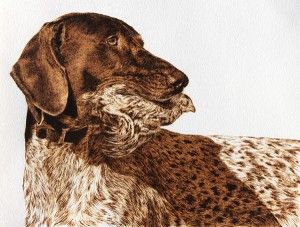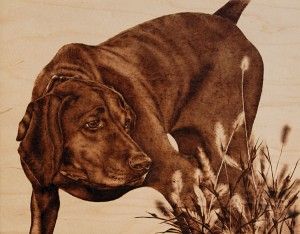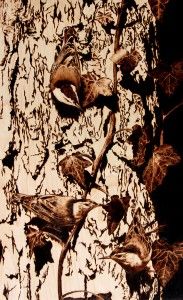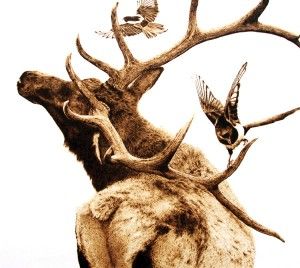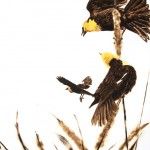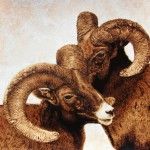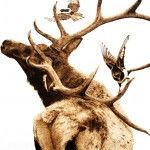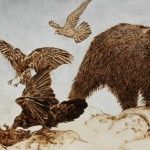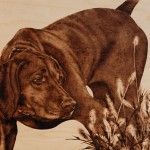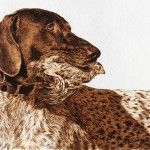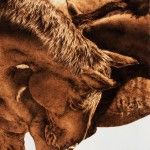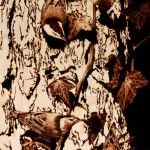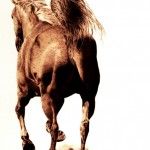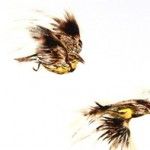Julie Bender takes fine-art pyrography to new heights
By Gussie Fauntleroy
This story was featured in the April 2014 issue of Southwest Art magazine. Get the Southwest Art April 2014 print issue or digital download now–then subscribe to Southwest Art and never miss another story!
Julie Bender sits at the oak worktable in her Loveland, CO, home, slowly and delicately applying the fine tip of a heated pyrography tool to heavy watercolor paper. Each meticulous, sepia-hued mark she makes—and the compelling animal imagery they collectively create—reflects her love for a sweet, intelligent vizsla named Zoë. With each careful adjustment of heat and pressure, with every steady movement of her hand, the 56-year-old artist is aware that her deeply satisfying career would never have happened if not for the dog that left her side too soon.
It was the late 1990s, and Bender was living in Atlanta, working an office job in project management, when a series of health and personal challenges plunged her into emotional turmoil. Her world felt empty and forlorn, and she rarely left home except to go to work. Throughout this difficult period, Zoë was constantly by her side, offering solace and unconditional joy. “She was my best friend, my moral support. We were so highly connected, so close,” the artist says. Then, in early 2002, Zoë became ill. Two months later she died. The depth of Bender’s love was matched by the intensity of her pain at Zoë’s death.
As she searched for an urn for the dog’s ashes, Bender knew she was also searching for a way to suitably memorialize her dearest friend. (Twelve years later, she still gets misty-eyed when she speaks of that time.) She finally settled on a cherry- wood urn, but it didn’t feel personal enough. Then she had the idea of burning a portrait of Zoë on the face of the urn. She went to a hobby shop and bought a $20 wood-burning kit. Because pyrography is an unforgiving medium—once a mark is burned into wood or paper, it cannot be changed—she had to go into the project “being very forgiving of myself,” she says. “I knew my marks would be permanent, and I knew I was doing it out of love.” As it turned out, she was pleased and even proud of the result.
As much as Bender was intrigued by “painting with heat,” as she calls it, it was a year before she attempted it again. The notion that creating an image of another dog could diminish Zoë’s memory was finally put to rest when she decided to repay a friend’s support by burning portraits of the friend’s two dogs on a plaque. “I really enjoyed that experience,” she says. Since then, she has not put pyrography down. Continuously refining her techniques and use of materials, Bender has become an award-winning signature member of the Society of Animal Artists. Her art, featuring western wildlife, horses, birds, and sporting dogs, is in the permanent collections of museums around the United States and public and private collections worldwide. One of her most valued honors came in 2011 when the Leigh Yawkey Woodson Art Museum purchased her piece IVY LEAGUE for its permanent collection.
The roots of Bender’s love of art are intertwined with a strong sense of self-reliance that began early in her life. “It’s in my DNA to resist the norm,” she says, smiling. A self-described city girl, she grew up in St. Louis, MO, with little access to the natural world. She remembers being fascinated, however, with sitting by the window with pencils and pastels and drawing the “landscape” of her backyard. Her artistic inclination was not encouraged or discouraged; it was simply there. “What’s interesting is that I always felt the pull to get my impressions down visually,” she relates.
A solidly responsible young woman, Bender put herself through school at the University of Missouri, earning a bachelor of fine arts and a bachelor of science in art education with the idea of teaching art. Soon after graduation in 1980, however, she moved to Chicago and found herself sidetracked into the newly emerging field of computer graphics. This led to a career in project and account management with software and web- development firms. Later she worked for the Centers for Disease Control in Atlanta, where she lived for 30 years.
Along the way she tried to respond to the continual pull toward art. She browsed art-supply stores and art magazines and always headed for the art section in bookstores, keeping up with current trends in fine art. At one point she bought some clay and dabbled in sculpture, remembering lessons from one of her favorite college courses. After Zoë’s passing and her discovery of pyrography, she knew she had found her path.
Initially Bender experimented with burning on various types of wood, beginning with the very soft basswood sold in hobby shops. She soon realized that hardwood, especially maple or birch, required her to apply heat slowly, allowing for a more precise touch and much greater detail. She began receiving commissions for dog portraits for memorials and for the wood bases of trophies. Yet mastering the demanding art of pyrography was only part of the challenge. Promoting her work also meant breaking down barriers in the fine-art world. “Because this medium was so unfamiliar to show directors, gallery owners, and private collectors, I was faced with the daunting task of advocating for my art alongside that of painters and other fine artists who had been in the industry decades before me,” she relates.
The art world did take note, and Bender soon found herself earning recogni- tion at national and international invitational and juried shows. She was still working full time in project management, however, and squeezing in pyrography when she could. That meant coming home, exercising her energetic dogs—since Zoë, she has had another three vizslas, a breed to which she remains devoted—and then sitting down to her art, sometimes all night.
Then one day in 2012, a supervisor at the CDC called Bender into her office and asked her to close the door. Her performance was excellent, but funding had been cut. “I remember thinking: This is my ticket, my golden ticket out of Atlanta,” the artist recounts. It was the opportunity she needed to move to a place with access to wildlife and a community of artists, where she could turn full time to art. She chose Loveland, a city steeped in the arts. Within three months she had sold her house in Atlanta, packed up, and moved. “Best decision I ever made,” she declares.
These days Bender spends as much time as possible observing and photographing such wildlife as elk, bison, bighorn sheep, moose, and birds in their wild habitats. Completely self-taught in pyrography, she continues to experiment with methods and materials, not only embracing the medium’s inherent complexities but also creating new challenges to forge ahead into uncharted artistic realms. Working primarily on heavyweight watercolor paper, she enjoys pyrography’s exquisite range of sepia tones. Yet she also finds that she and viewers respond strongly to the visual dimension that emerges through the selective addition of color in acrylics, oil pencils, or conté crayons. She has begun exploring the selective use of nonburnable materials, as well. In AMID THE CATTAILS, for example, she produced a looser, softer look by sprinkling sand on areas of the image and burning around it, then brushing off the sand.
While the art of pyrography is highly time-intensive, Bender also invests a significant amount of thought and creativity into the conception and composition of each piece. After closely observing magpies and elk after the rutting season, for instance, she spent weeks pondering several ideas before creating a scene similar to one she had witnessed in the wild. The result was the striking image SHAKEN, NOT STIRRED [see page 62]. As with all her art, it was created by using heat to slowly build multiple layers of subtle values and tones. In 2013 the work was juried into the 38th annual Birds in Art exhibition at the Leigh Yawkey Woodson Art Museum in Wausau, WI.
“What makes my heart pound hardest as I conceive a work is being able to produce emotion-eliciting scenes or events,” Bender says. “It is such a gift to observe these incredible animals and immortalize them in an authentic and evocative way. My greatest reward is having a work resonate with a collector to the point where they want it for their collection.” The effort and time commitment required for this level of mastery only spurs the artist on. “Since I found pyrography, it has become more than a passion. It’s my calling. I could do it all day and all night,” she reflects. “And there’s not a day that I sit down to work that I don’t think of Zoë. She continues to be the greatest gift in my life.”
representation
Trailside Galleries, Jackson, WY, and Scottsdale, AZ; Wood River Fine Arts, Ketchum, ID.
Featured in the April 2014 issue of Southwest Art magazine–click below to purchase:
Southwest Art April 2014 print issue or digital download Or subscribe to Southwest Art and never miss a story!
- Julie Bender, Amid the Cattails, pyrography/acrylic on paper, 18 x 15.
- Julie Bender, Matter of Opinion, pyrography/Conté/acrylic on paper, 13 x 19.
- Julie Bender, Shaken, Not Stirred, pyrography on paper, 22 x 25.
- Julie Bender, To the Victor Belong the Spoils, pyrography/acrylic on paper, 15 x 28.
- Julie Bender, Your Move, pyrography on wood, 11 x 14.
- Julie Bender, Reload, pyrography on paper, 12 x 15 .
- Julie Bender, Comfort Zone, pyrography on paper, 17 x 15.
- Julie Bender, Ivy League, pyrography on wood, 18 x 11.
- Julie Bender, Sun-kissed, pyrography on paper, 20 x 15.
- Julie Bender, Where’s the Fire?, pyrography/acrylic on paper, 8 x 24.
MORE RESOURCES FOR ART COLLECTORS & ENTHUSIASTS
• Subscribe to Southwest Art magazine
• Learn how to paint & how to draw with downloads, books, videos & more from North Light Shop
• Sign up for your Southwest Art email newsletter & download a FREE ebook






